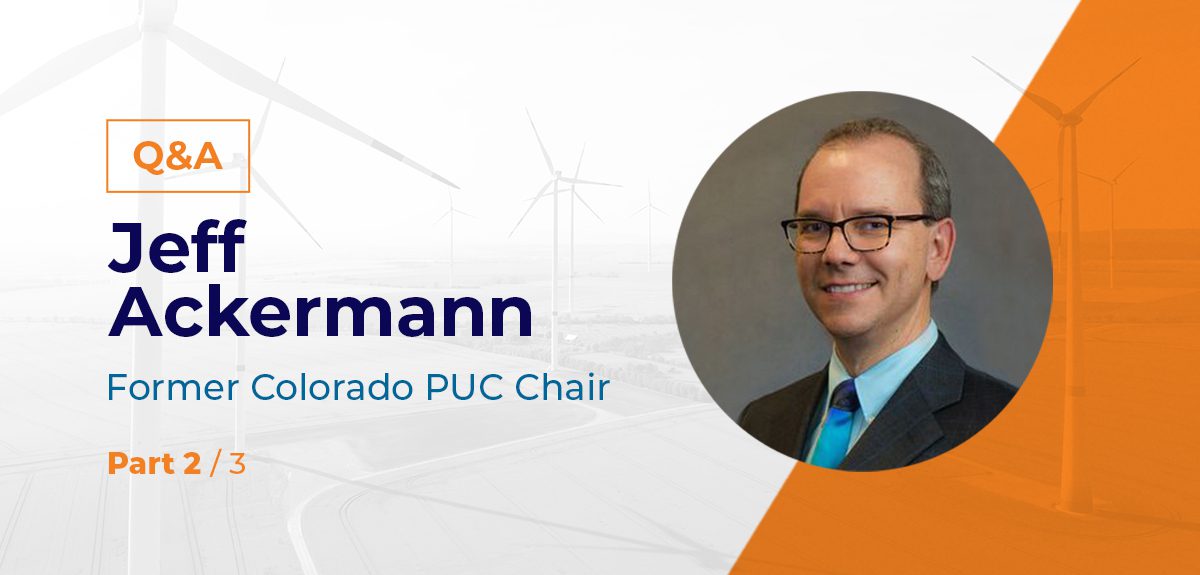Jeff Ackermann, the former chair of the Colorado Public Utilities Commission and current senior policy advisor at The Center for the New Energy Economy, recently spoke with Virtual Peaker about how utilities are at a crossroads—the intersection of aging infrastructure, regulatory policy, and climate change. For many, there seems to be a willingness to invest in new generation capacity, renewables, energy storage, and distributed energy resources. The path to decarbonization is challenging, and Ackermann’s insights are invaluable. Read on to learn more about the economic and grid resiliency opportunities that distributed energy resources provide to enterprising utility operations.
What Are the Greatest Opportunities for Distributed Energy Resources in 2022 and Beyond?
Jeff Ackermann: I think that there are great opportunities to make distributed energy resources (DERs) fit into the existing model versus completely changing the industry construct.
I see DERs as a great capital investment, and I’ve been an advocate for years. When demand-side management was rising 14-15 years ago, I was advising the Colorado commissioners on whether they should take energy efficiency and treat it as a capital investment. It’s comparable to a broad definition of distributed energy resources, from a load management and load shift perspective, so I’d like to see them viewed as a capital investment that then can entice utilities to devote even more resources.
Funding the Distributed Energy Resource Initiatives of Tomorrow
JA: In my own backyard in Colorado, there’s currently a struggle to find funding for a community solar project. A local utility is pushing back on a plan to provide 75 megawatts of new solar garden construction for low-income customers, asking state regulators to step in. (Note: I’m no longer a regulator, and I’m not taking a position on this case. I’m mentioning it to illustrate some of the opportunities—and challenges—of distributed energy resources.)
– Jeff Ackermann, Former Colorado PUC Chair
The project represents a great way to bring renewable energy to an under-served population, not as a traditional subsidy (although it’s funded in a small part by a surcharge on all utility ratepayers), but by providing clean, lower-cost electricity for purchase by this population. Unfortunately, the solar installation estimates far outpace what’s available in the renewable energy fund. We can debate the merits of the case, but the larger point for moving forward with DERs across the country is that traditionally it’s part of a utility’s corporate DNA to not want to invest in power generation it doesn’t own and control. That mindset limits what we can do with distributed energy resources.
Climate Change and Distributed Energy Resources
JA: The highly destructive fires this winter and spring in Boulder County, Colorado, beg the question of how climate resiliency should be part of utility planning. There are lots of things we can do, from microgrids to islanding to non-traditional grid hardening for places like hospitals and schools and other key infrastructure. But, everything has a price tag. The dynamics can be tricky, and the obvious question is where the money comes from—utilities, state commissions, the federal government—to make it happen. How can we leverage federal dollars to create viable opportunities for distributed energy resources in 2022 and beyond?
Interview Takeaways: Greenlighting the Distributed Energy Resources Transition
Distributed energy resources are one of the best tools available to utilities to help mitigate the impact of climate change in the face of increasingly frequent climate-related disasters. Current and future regulators will face the ongoing challenge of determining the best ways to fund the essential work that will bring more distributed energy resources online to make our approach more sustainable. For Virtual Peaker clients, the Gravity Connect® API lowers development times and costs, and the SaaS-based Virtual Peaker platform is scalable and flexible to meet growing demand.
(Virtual Peaker asked Jeff Ackermann three primary questions, which we’re sharing in separate installments. See here for part 1. We’ll be posting part 3 of our conversation soon. The discussions have been edited for length and clarity.)






